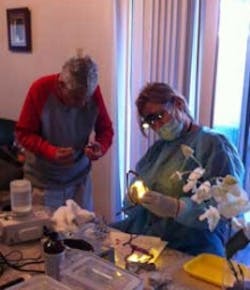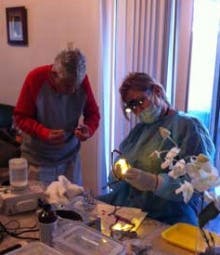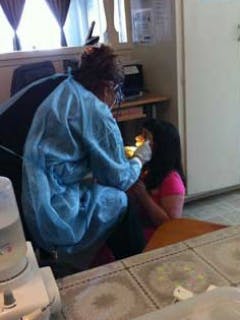Kiancare
Kian fixing a patient’s glasses during an oral hygiene visit to the home.
An RDHAP visits homes to give clients access to care
By Noel Brandon Kelsch, RDHAP
She softly held his hand for a moment. Even though he could not respond, it was clear in the relaxing of his facial muscles that he knew he was with someone who cared, someone who had his best interests at heart … someone who would go above and beyond to make sure he was comfortable. He knew from past experience it was Kian.
In a middle class neighborhood in Southern California, surrounded by orange groves and amusement parks, a brick home stands trimmed in climbing rosebushes. It looks like any other home on the street. The street is lined with houses that reflect the owners’ pride and joy in living in a safe and supportive neighborhood. The six people who call this dwelling home all have something in common that has brought them to this mainstreaming home. Each of these citizens has a special need that requires them to be aided in daily life. Kian Masoumi, registered dental hygienist in alternative practice (RDHAP) is one of the many different health-care professionals who come directly to the home to give clients access to care. Her independent practice dental hygiene services are making a difference for these clients.
The business of hygiene
Mission statement: When Kian entered the RDHAP program, the first thing she did was put together her mission statement to aid her in the direction she wanted her business to go.
“When I am looking at my business and trying to decide on a direction or project, I just go back to my mission statement and see if it matches what my business stands for. If it doesn’t, I don’t do it,” Kian stated. Her mission statement, which is clear in her business and interaction with clients and staff is: Impact oral hygiene to eliminate edentulism in underserved populations.
Business model: Kiancare’s dental hygiene business success of more than four years included using the framework of three basic business concepts:
1. Time management: In order to manage the time, Kian first hired a dental assistant who also functions as an office manager. Carlos Piche is a predental student. He does everything from billing, scheduling, and coordinating to assisting with clients. Kian realized early on that she could not do everything, so she chose to do the things that only an RDHAP would be allowed to do. The California State Dental Practice Act allows RDHAPs to perform all the functions they do in an office setting (except dispense nitrous oxide and local anesthesia) without the supervision of a dentist in underserved venues. Kian hired her assistant to do tasks that the dental practice act allows a dental assistant and office staff to do.
“Having Carlos as my assistant and office manager has had the greatest impact on the success of my business. Hiring the right staff will make all the difference in your day-to-day schedule, the effectiveness of your office, and how you feel about doing your job. Carlos’s passion and professionalism impacts what I do every day.” She also hired other RDHAPs when she started getting more clients than she could handle on her own. “One of the concepts you have to embrace is to look at each task and see how it can be accomplished at the highest quality care level and for the least amount of cost. Including the use of auxiliary staff will allow you to lower the cost of tasks and still meet all of your clients’ needs,” Kian explained.
2. Utilization of in-place facility staff: One of the hardest things for an RDHAP and auxiliary staff is the impact on their bodies when working in this environment. Having the staff move clients and assist in client care when appropriate will do three things: Limit the amount of lifting necessary, comfort the clients since they are familiar with the facility staff, and help the staff to become at ease with oral care. Staff members are very aware of each client’s special needs. They know how to move clients and are always willing to assist.
3. Financial planning and capital investment: Kian’s initial capital investment was about $80,000 for equipment and supplies. From the inception of the business, financial awareness has been a major key in the planning. Cost of patient supplies, billing, and overhead are evaluated before capital investments and additions to services are made. Knowing that it costs $3 per patient to set up supplies and that there’s an hourly cost for mobile dentistry allows the business to make sound financial decisions. This will minimize losses due to lack of planning. The business has grown, which has allowed a greater understanding of the impact of capital investment. The business is paid through grants, the state Denti-cal program, and private funding.
Kian shares, “If you are doing this for money, it will not work. When you deliver care from the heart, the money will follow.”
Treatment in the field: Kiancare’s philosophy is that the standard of care does not change because you are outside the four walls of an office. The care given in this setting should reflect the quality of care that is given in all settings. Adaptation is the key.
Kian treating a client under the desk
Kian’s goal of maintaining the standard of care and delivering quality dental hygiene is very clear. Everything that a hygienist performs in the office setting from health history review to evaluation is performed. With simplified mobile units, she sets up an actual mobile operatory. Each hygienist is able to see about five to six clients a day. The time required for each client is from 45 minutes to an hour-and-a-half average. These clients require more time, and just like you and me, they have good days and bad days. The method of delivery of care is simplified, but it is the same care you would receive in a dental setting. An inexpensive DeVilbiss medical pump is used for suctioning, and scaling is performed with hand instruments and a piezo unit with built-in. Kiancare system of care is able to deliver complete dental hygiene care in the same manner as that delivered in the dental office setting.
Treatment protocol
Days before: Kiancare’s plan is to minimize lost time and maximize organization. The office manager calls the facility ahead of time to remind about the appointment and the need for premedication (if necessary). A request is made that all health histories and oral treatment plans be updated, and information on any changes be phoned in to Kiancare. This helps eliminate wasted time when clients are not able to receive treatment. Due to the nature of our clients’ health, it is sometimes necessary to rearrange appointments. Staff must be adaptable to a schedule that varies from day to day.
Upon arrival at the facility, the mobile setting equipment is unloaded. The RDHAP goes into the office and updates all health histories and treatment plans. The RDHAP then goes directly to the staff and works with them on oral home care for the clients. The assistant starts setting up the mobile field and arranging clients. Facility staff assists with transporting clients and helping to comfort them and position them during care.
During treatment, the assistant suctions and assists with equipment transfer. During the process, the RDHAP uses desensitization techniques to help calm the patient, including sound, touch, and sensory stimulation. These techniques help clients at every level.
After treatment is complete, the RDHAP does charting and the assistant disinfects the environment and sets up for the next appointment. At the end of the day, infection control protocol is followed with flushing of the line, packing up instruments to be sterilized, etc., and the car is loaded.
Tips for care:
1. Use a 4x4 rather than a 2x2 piece of gauze. This will require less changing of the item. Once you get the patient in position, you do not want to have to keep stopping to make changes.
2. Use the bibs that the facility has on hand. Most facilities have great bibs that you can use, and the patient is familiar with those bibs.
3. Always work with the dentist who is seeing your client. Find out what their treatment plan is and see where they are on it. Communication in this area is vital. You need to work as a team even though the businesses are independent. It is much like when a client is referred from a general practitioner to an endodontist. The communication between those two offices will impact the treatment plan. Always check to see the status of treatment each time you visit the facility.
Training the staff at the facilities
Kiancare’s first aim is to educate the staff in the facility. “You can scale all you want but if your staff does not help the client, your scaling was in vain,” according to Kian. “Each facility is just like a home. You must first understand the patient’s home life environment, inner workings of the staff, their level of understanding, and their ability to deliver oral care. The ultimate responsibility of oral care belongs to the caregivers; therefore they are your greatest tool.
“I first give each staff member a toothbrush and toothpaste tube for personal use. I go over the basics such as the impact of pressing too hard with the toothbrush and having a nice-tasting toothpaste. I teach them basic desensitization skills to use while helping clients with their oral hygiene. On each return visit, the procedure is reinforced and staff works with the RDHAP to see the impact of the care they are giving to patients.”
One client’s story
Kian believes you should never give up on clients. They have to trust you to allow you to enter one of the most intimate parts of their bodies. You never know what has happened to the client in the past, so you must cultivate trust before you enter the mouth.
On the first visit, Sam was very combative. Kian calmly talked to him, and did not force him to do anything. As she came back to see other clients, she would visit Sam too. On the second visit, she sat next to him and again spoke gentle words to him.
Each time she visited, she increased the closeness and tactile stimulation, making him more familiar with her voice, movements, and equipment. On the next visit, she asked permission to touch his face, and he allowed her not only to touch his face but to brush his teeth as well. In giving Sam the power to choose, they developed a relationship of trust. Kian is now able to meet all of Sam’s dental hygiene needs without resistance.
“We cannot just go by outward appearance or the patient’s behavior. They all have dental histories that may have brought them to this behavior. Just like us, each client has good days and bad days; the difference is you can call and reschedule or have verbal cues you can share. It is so important to take the time to look at all the ways clients communicate and respect their desire to receive treatment or decline today,” Kian said.
Tips from the field
Billing: Require private-pay clients to pay at the time of service. Do the billing while you are there, eliminating the need to mail the bill and wait on client funding. Let the conservator know ahead of time the estimated amount of cost of services.
Insurance: Call the insurance companies and get a complete understanding of their systems. Take any courses they offer to utilize their systems. Plan on being on hold! When you call many times, the insurance company will put you on hold. Plan on calling the company and staying on hold while you do other tasks. Have your list of questions ready.
Relationships: There are many companies that have been trying to take over private practices and come in and establish relationships with facilities. In the United States, federal law states that patients have the right to choose their health-care providers. No company can take away that right from clients.
Establish a relationship with your clients, their conservators/families, and the facilities. Get the contact information for family and conservator. Have the patient/conservator sign a paper that states you are their caregiver of choice. This will help your business if a company comes in and has a contract with the facility to deliver care. The success of your business will be greatly impacted by the relationships you build with staff, clients, and conservators. Bring each staff member a toothbrush and compliment them on the efforts they make to keep the clients healthy.
Advertising: Word-of-mouth is the single most effective method of advertising that Kiancare uses. “When you are giving your clients a high standard of care, your reputation will impact the amount of business,” according to Kian. “I have used a simple trifold brochure when people want more information. This should include what the business is, what the staff can do for underserved populations, and contact information. I have found that business cards are not enough since most people do not even know what an RDHAP is. Determine the population that you want to work with and develop the trifold around that dream.”
Ethics and consistency: When hiring staff, including RDHAPs, it is vital that they have the same standards and ethics that you have. Most importantly, it is your responsibility to check their work and their interaction with clients and staff. The delegation of duties does not end your responsibility. These staff members are representing you; they need to have the same products, training, philosophies, and standards as you.
Travel time: This business serves many cities in the Orange County, Calif., area (almost 800 square miles). It is vital to map out the area and route ahead of time. This will help eliminate wasted time on the road and allow you to maximize the expenses of gas and transportation. There are many systems on the Internet that will allow you to map out the best routes. Many GPS systems also have this feature.
Accomplishments: When Kian was asked what the greatest accomplishment of Kiancare was, Kian stated, “The greatest accomplishment is seeing my clients smile. Some clients are verbal and some are not, but seeing their smiles makes this all worthwhile.”
The client Kian was seeing while I talked with her was unable to communicate through speech. He tilted his head and pressed his trembling finger to his chin. The aide said, “He is telling Kian thank you.” A young lady who sat hunched over and watching us during our visit slowly stretched her body up, lifted her chin, and smiled in Kian’s direction. Her effort was clear and her smile was a direct reflection of the efforts that Kian had made.
Kian shared, “A hero is the person who treats people like they would want to be treated no matter their status in life. Every time you do an action, you have to remember that thought.” It is clear in the business of Kiancare that Kian is a HERO!
Noel Brandon Kelsch, RDHAP, is a syndicated columnist, writer, speaker, and cartoonist. She serves on the editorial review committee for the Organization for Safety, Asepsis and Prevention newsletter and has received many national awards. Kelsch owns her dental hygiene practice that focuses on access to care for all and helps facilitate the Simi Valley Free Dental Clinic. She has devoted much of her 35 years in dentistry to educating people about the devastating effects of methamphetamines and drug use. She is a past president of the California Dental Hygienists’ Association.
Definitions
Mainstreaming home: Six clients with special needs from cerebral palsy to brain injuries live together in a home within the community. Staff members assist them with activities they cannot complete themselves, such as oral hygiene and dressing. This mainstreaming home system allows them to live as independently as possible in a supportive community.
Clients: The preferred name for people living in this mainstreaming home setting is clients. The name patient is associated with illness. Client, on the other hand, is a word of health and has a positive connotation.
Past RDH Issues


